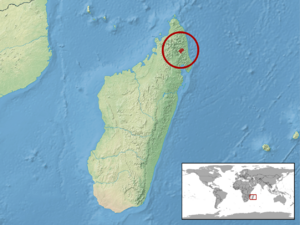Naturelle leaf chameleon facts for kids
Quick facts for kids Naturelle leaf chameleon |
|
|---|---|
| Conservation status | |
| Scientific classification | |
| Genus: |
Brookesia
|
| Species: |
karchei
|
 |
|
| Geographic range of Brookesia karchei in Madagascar. | |
The naturelle leaf chameleon (Brookesia karchei ) is a special kind of chameleon. It is a small lizard that belongs to the family called Chamaeleonidae. This chameleon is only found in one place: the island of Madagascar. This means it is endemic to Madagascar.
Sadly, the naturelle leaf chameleon is an endangered species. This means it is at high risk of disappearing forever. The International Union for Conservation of Nature (IUCN) has listed it as endangered on its Red List of Threatened Species. Scientists Édouard-Raoul Brygoo, Charles Pierre Blanc, and Charles Domergue first described this species in 1970.
What's in a Name?
The second part of the chameleon's scientific name, karchei, honors a geologist named Jean-Paul Karche. Scientists often name new species after people they want to remember or thank.
Where It Lives and Why It's in Danger
The naturelle leaf chameleon lives in Marojejy National Park in Madagascar. This park is a large natural area with many mountains and forests. These chameleons are found at heights between 380 and 850 meters (about 1,247 to 2,789 feet) above sea level.
This chameleon lives in humid, wet forests. It spends its time on the ground, hidden among the leaves. The area where it lives is about 597 square kilometers (231 square miles).
The biggest threat to the naturelle leaf chameleon is the loss of its forest home. People cut down valuable rosewood trees from these forests. This logging destroys the chameleon's habitat. Even though we don't know exactly how many of these chameleons are left, losing their forest home is a serious problem. Because of this, collecting these chameleons, or any others, is against the law in Marojejy National Park.
How Big Is It?
Female naturelle leaf chameleons are quite small. Their body length, from snout to the start of their tail, is about 30.7 millimeters (about 1.2 inches). When you include their tail, their total length is around 51.0 millimeters (about 2 inches).


